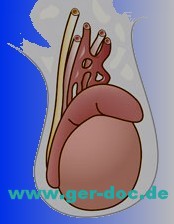
Mammary cancer
Mammography
Examination was accomplished in standard projections: straight and oblique. The mammary glands are symmetrical.
The areolas are output at a contour. The skin is not thickened, not condensed. The bands of fibrous tissue – Cooper’s ligaments are left from the skin. The premammary space is not constricted. A tissue of the mammary gland is presented in central and lateral areas by the glandular tissue, in medial by adipose and line diffuse fibrosis in all quadrants. The density of both breasts has the 2nd grade.
At this background of pathological masses, no micro calcinations are detected
Single micro calcifications are visualized on the border of inferior quadrants of the left breast.
A vascular grid is well defined.
No abnormalities of the lymph flow zones on the right and on the left.
ECHO MAMMOGRAPHY
The mammary glands are symmetrical. The skin is not changed.
The mammary glands have the usual structure for this age.
The differentiation of tissues is evident sufficiently.
Cooper’s ligaments which go deep are thickened and condensed.
Galactophorous ducts are moderately dilated till 2.0-2.5 mm.
No pathological parts of vascularization are detected.
Parts near areola are without any changes.
Impression: No signs of malignizalion are detected. ACR1 is for the right and ACR2 is for the left breast. The density of both breasts has the 2nd grade. Ultrasonic signs of diffuse changes of the breasts by the type glandular mastopathy.
General examination: The patient complaints for having a mass in the upper-internal quadrant of the left breast, which she noted in August 2012. She has felt enlargement of this mass in sizes from August till today.
Data of previous consultations – 28 of May 2012 – mammography, Breast use – ACR1 is on the right, ACR2 is on the left.
For the period from May till November felt changes in hormone therapy, climate changes (lived in Uzbekistan in summer).
St. localis: The mammary glands are symmetrical, and the regular color. The skin is not condensed under them. A mass of rounded form with solid non-crushing consistency and unconsolidated with surrounding tissues till 2 sm is palpated in the upper-internal quadrant of the left breast. Palpation is without pain. The axillary lymph nodes are not palpated.
Breast ultrasound: The mammary glands are placed typically; the skin is without any changes. The differentiation of tissues is expressed in both breasts. The correlation of adipose and glandular tissue: 1/3.
The Galactophorous ducts are thickened a little in both breasts till 2.0-2.1 mm. Cooper’s ligaments are not thickened and not expanded.
A dimensional, massive, hypo echoic and avascular mass of oval form 17.4×10.3 mm, which has calcinations in the center is located in the left breast in the upper-internal quadrant. No areas of pathological vascularizations. The regionary lymph nodes are not increased.
Impression: Ultrasonic signs of moderate diffuse changes of both breasts by the type of glandular mastopathy. Signs of dimensional mass of the left breast (fibro adenoma?). Biopsy of the pathological mass of the left breast is recommended.
HYSTOLOGY EXAMINATION
Tissue labeling, number of objects: №1 – biopsy of the tumor of the left breast.
Clinical diagnosis: Malignized tumor of the left breast.
Macroscopic description: 4308-01, 02 – two (2) grey color bands with brown areas and with the length of 1.7 sm each.
Microscopic description: Conclusion: Enlargements of invasive ductal carcinoma Grade III are revealed in all biopsy samples in the tissue of the mammary gland.
Mammography
Examination was accomplished in oblique views. The mammary glands are symmetrical and not deformed. The skin is not thickened, not condensed.
The bands of fibrous tissue – Cooper’s ligaments are left from the skin. The premammary space is not constricted.
A tissue of the mammary gland is mainly presented by glandular tissue, in medial areas by adipose tissue and line diffuse fibrosis in all quadrants.
High intensity without clear contours of rounded mass till 18 mm in diameter, which is located retromammary, containing single polymorph micro calcinations is revealed at this background on the border of internal quadrant of the left breast. Behind the mass, a single line calcination is visualized. Abnormality of architectonic of structured picture of the central part of the left breast due to stroma deformation is revealed. A vascular grid is well defined.
No abnormalities of the lymphatic flow on the left and on the right.
IMPRESSION: ACR1 is for the right and ACR4 is for the left breast. X-ray signs of dimensional mass of the left breast.
MAGNETIC RESONANCE IMAGING BREASTS
Description of the research:
A mass of rounded form with even contours and sizes 16x11x17 mm due to active accumulation of contrast material more on the periphery with washing-out to the 3rd minute is revealed in the left breast in the deep areas of the breast in the upper-internal quadrant. The mass is surrounded by the rich vascular grid.
No pathological changes in the right breast. No areas of accumulation of contrast material in the lymphatic nodes are detected.
No bone destructive changes.
IMPRESSION: MR picture of the left breast damage, probably, having neoplastic nature. Biopsy is recommended to make verifications.
Magnetic resonance tomograph EXCELART Vantage Atlas-X 1,5 T Toshiba
Complaints: for having occasional pain in the breasts and having a tumor-like mass of the left breast.
History of the disease: After self-palpation in April 2012, the patient noted a tumor-like mass for the first time.
General examination: Micromastia. The breasts are asymmetrical in the inferior-internal quadrant of the left breast. Vertically oriented tumor-like mass of the solid consistency with sizes 20-27 mm is palpated (the patient notes enlargement of the tumor after biopsy). No skin symptoms. Regionary lymph nodes are palpated not clear. No nipple discharge.
Diagnosis:
C50.3 Cancer of the left breast T3NxMx
Differentiated diagnosis: diagnosis is verified. Plan of examination: Mammography.
Treatment: Additional consultation of oncomammologist and chemotherapist for defining indications to have possible neoajuvant chemotherapy.
Рecommendation
Treatment in Germany.
Ideal: treatment in Munich.



















